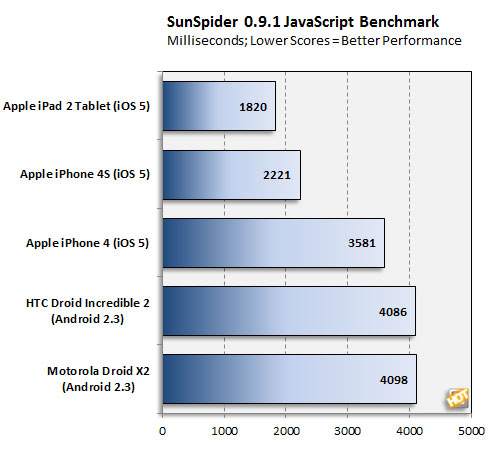Apple iPhone 4S: What's In It For You vs iPhone 4?
|

|

The iPhone 4S jumps out ahead of the other smartphones by a good clip in the SunSpider JavaScript benchmark and nearly catches up to the faster clocked iPad 2 tablet. That's impressive. Things are a little closer in BrowserMark, though the iPhone 4S still leads the smartphone pack.

GeekBench takes an in-depth look at both processor and memory performance, and is multi-core aware. Unfortunately it's not compatible with Android (yet), but it does allow us to see what kind of gains are possible with the iPhone 4S versus the iPhone 4. Posted above are the results for the iPhone 4S, and with an overall score of 618, it shows that there are some instances where it can run twice as fast (or nearly twice as fast) as the iPhone 4, which scored 381. For the sake of comparison, the iPad 2 scored 756.
On a side note, ignore the Processor Frequency that GeekBench displays, because it's probably wrong. There have been reports that the iPhone 4S is clocked at around 800MHz based on its benchmark scores. For what it's worth, GeekBench mislabeled our iPad 2's clockspeed at 897MHz when the actual clockspeed is 1GHz.
Subjective Analysis:
Hard numbers are great when you need to compare device A to device B, but what about day-to-day performance? What the numbers don't reveal is just how snappy the iPhone 4S is. This is where the iOS platform really shines, especially if you're coming from an Android device that's weighed down by a heavy skin, like some Motorola devices. The Droid X2, for example, should fly by the seat of its pants, and in some cases it does. But next to the lesser spec'd iPhone 4S, it's pretty well grounded. The iPhone 4S is snappy, apps load instantly, and there's never any lag as you navigate the UI. It feels comparable to the iPad 2, only in a smaller form factor.
As to battery life, Apple claims you can manage up to 8 hours of talk time on 3G, up to 14 hours on 2G (GSM), 200 hours of standby time, up to 6 hours of Internet use on 3G, up to 9 hours on Wi-Fi, up to 10 hours of video playback, and up to 40 hours of audio. These are comparable numbers to the iPhone 4, and in my real-world usage analysis, there's nothing to get overly excited about one way or the other. I've been able to go more than a day with what I would consider to be normal usage habits -- some calling, texting, playing with apps, shooting pics, listening to Pandora, and so forth. You're mileage will vary, of course, and if you're watching hours of Netflix movies with the screen brightness cranked up, you'll have to charge it more often.






